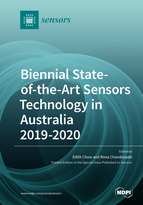Biennial State-of-the-Art Sensors Technology in Australia 2019-2020
A special issue of Sensors (ISSN 1424-8220). This special issue belongs to the section "State-of-the-Art Sensors Technologies".
Deadline for manuscript submissions: closed (31 December 2020) | Viewed by 24541
Special Issue Editors
Interests: chemical sensors; electrochemical sensors; gold nanoparticles; paper-based sensors and devices; nanozymes
Interests: nanoparticle sensors; biosensors; early disease diagnosis; food and health monitoring; drug delivery; nitric oxide; enzymes and enzyme mimics; biomaterials; cell-material interactions; bioconjugation and surface chemistry
Special Issues, Collections and Topics in MDPI journals
Special Issue Information
Dear Colleagues,
Recent developments in novel materials, sensing principles, and signal processing are paving the way for new types of analytical sensors offering improved sensing performance and practicality. Such advancements will provide accurate and real-time analytical information in the environmental, food, and healthcare sectors to better guide decision-making. For sensors to be commercially viable, miniaturization and integration of components for rapid, automated, and in-field detection and diagnosis need to be considered. This Special Issue will highlight state-of-the-art sensors technology in Australia through original contributions and reviews.
Dr. Edith Chow
Dr. Rona Chandrawati
Guest Editors
Manuscript Submission Information
Manuscripts should be submitted online at www.mdpi.com by registering and logging in to this website. Once you are registered, click here to go to the submission form. Manuscripts can be submitted until the deadline. All submissions that pass pre-check are peer-reviewed. Accepted papers will be published continuously in the journal (as soon as accepted) and will be listed together on the special issue website. Research articles, review articles as well as short communications are invited. For planned papers, a title and short abstract (about 100 words) can be sent to the Editorial Office for announcement on this website.
Submitted manuscripts should not have been published previously, nor be under consideration for publication elsewhere (except conference proceedings papers). All manuscripts are thoroughly refereed through a single-blind peer-review process. A guide for authors and other relevant information for submission of manuscripts is available on the Instructions for Authors page. Sensors is an international peer-reviewed open access semimonthly journal published by MDPI.
Please visit the Instructions for Authors page before submitting a manuscript. The Article Processing Charge (APC) for publication in this open access journal is 2600 CHF (Swiss Francs). Submitted papers should be well formatted and use good English. Authors may use MDPI's English editing service prior to publication or during author revisions.
Keywords
- Chemical sensors
- Biosensors
- Electrochemical sensors
- Optical sensors
- Environmental sensors
- Food quality sensors
- Gas sensors
- Disease diagnosis
- Lab-on-a-chip
- Paper-based devices
- Wearable technologies








